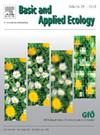郊区森林植物物种多样性的驱动因素:捷克共和国的案例研究
IF 3.5
2区 环境科学与生态学
Q2 ECOLOGY
引用次数: 0
摘要
城市化与土地利用变化一起显著改变了周围的栖息地,影响了植物物种的发生及其形成的群落的多样性。然而,关于影响郊区森林植物物种组成的个别环境驱动因素的详细信息仍然有限。在这项研究中,我们的问题是:郊区森林中植物物种多样性的主要驱动因素是什么?在捷克共和国布尔诺市及其周边地区,我们调查了110个喜酸性橡树和角木林的植被样地。利用广义线性模型和典型对应分析,研究了城市环境驱动因素对不同植物物种特征的影响。城市化是最重要的驱动因素,因为森林附近的人工地表降低了物种的总丰富度,增加了干扰的严重程度和非本地物种的比例。较大的森林面积支持了森林专家的存在,并限制了竞争性通才的传播。被农业区包围的开阔林分促进了受威胁物种的持续存在。尽管基岩普遍呈酸性,但土壤pH值的变化(在城市地区很常见)也会影响植物物种多样性。此外,森林管理显著影响植被组成,而不受周围土地利用的影响。根据我们的研究结果,确保足够的森林面积,减少干扰,保持栖息地的连续性,增强景观连通性是城市规划中保护近天然森林的必要条件。橡树和角梁林的管理应旨在创造更多的开放林分,支持林下植被的更新,防止环境退化,以维持其所需的生态系统功能。本文章由计算机程序翻译,如有差异,请以英文原文为准。
Drivers of plant species diversity in suburban forests: A case study from the Czech Republic
Urbanization, together with land use changes, significantly transforms surrounding habitats, affecting the occurrence of plant species and the diversity of communities they form. However, detailed information on the individual environmental drivers influencing plant species composition of suburban forests remains limited. In this study, we ask: What are the main drivers of plant species diversity in suburban forests? In the city of Brno, Czech Republic, and its surroundings, we surveyed 110 vegetation plots of acidophilous oak and hornbeam forests. Using generalized linear models and canonical correspondence analysis, we studied the effects of urban environmental drivers on various plant species characteristics. Urbanization was the most significant driver since artificial surfaces near forests decreased total species richness and increased both the disturbance severity and the proportion of non-native species. Larger forest areas supported the presence of forest specialists and limited the spread of competitive generalists. Open forest stands surrounded by agricultural areas promoted the persistence of threatened species. Despite the prevailing acidic bedrock, variation in soil pH – common in urban areas – also influenced plant species diversity. In addition, forest management significantly affected vegetation composition, independently of the surrounding land use. Based on our findings, ensuring sufficient forest area, minimizing disturbance, maintaining habitat continuity, and enhancing landscape connectivity are essential for conservation of near-natural forests in urban planning. Management of oak and hornbeam forests should aim to create more open stands, support understorey regeneration, and prevent environmental degradation to sustain their required ecosystem functions.
求助全文
通过发布文献求助,成功后即可免费获取论文全文。
去求助
来源期刊

Basic and Applied Ecology
环境科学-生态学
CiteScore
6.90
自引率
5.30%
发文量
103
审稿时长
10.6 weeks
期刊介绍:
Basic and Applied Ecology provides a forum in which significant advances and ideas can be rapidly communicated to a wide audience. Basic and Applied Ecology publishes original contributions, perspectives and reviews from all areas of basic and applied ecology. Ecologists from all countries are invited to publish ecological research of international interest in its pages. There is no bias with regard to taxon or geographical area.
 求助内容:
求助内容: 应助结果提醒方式:
应助结果提醒方式:


